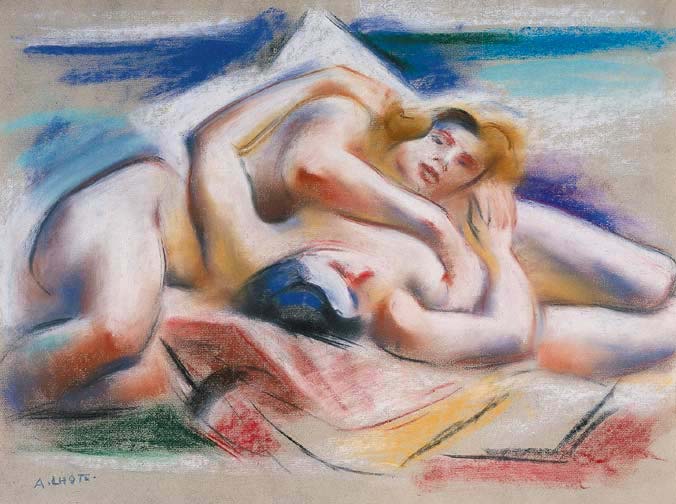

ANDRE LHOTE
"LA PLAGE"
PASTEL, SIGNED
FRANCE, C.1927
17.75 X 24 INCHES
André Lhote Lhote was born in Bordeaux, France in 1885. He left grade school at age thirteen to become an apprentice at a local sculpture studio while formally studying sculpture at l’École des Beaux Arts.
Lhote’s early
works similar to those of the Fauvists, exhibit a sense of rhythmic
gesture, simplification of shapes, and intense color. Several of these
works are illustrated in Jacovsky’s André Lhote. The Cézanne
Retrospective in the Salon d’Automne of 1907 profoundly affected
Lhote’s development. In 1908 the Groupe du Bateau-Lavoir was formed,
of which Lhote was an early member. This was the original Montmartre
Cubist Society, so named, for the tenement in which Picasso was living. In 1910, Lhote's
work was exhibited at the Salon des Indépendants, the official
launching of the Cubist movement in Paris. The response to his paintings
was so favorable that he was soon offered his first solo exhibition
at the Galerie Druet. Critics, contemporaries, and writers in Paris
such as André Gide, André Salmon, and others contributed
their full support to Lhote at this time. Following this triumph, his
work was exhibited at the Salon in 1911 and 1912 with the major Cubists
of the era. Lhote soon joined
the independent Cubist group Section d’Or along fellow pioneers
Albert Gleizes, Jean Metzinger, Fernad Léger, Francis Picabia,
Frans Kupka, Juan Gris, and Alexander Archipenko. Lhote contributed to the development of Synthetic Cubism in his writings as well as with his paintings. He often defended his ideas in Nouvelle Revue Française. Indeed, Robert Rosenblum in his Cubism and the Twentieth century Art has called Lhote “the official academician of Cubism.”
André Lhote has been honored in France on a number of occasions. He was awarded the National Grand Prize of Painting in 1955 and was honored in 1958 as Commander of the Order of Arts and Letters. Retrospectives of Lhote’s work were held at the Musée d’Art Moderne in Paris in 1958, and at the Musée Toulouse Lautrec in Albi, 1962, the year of his death. His paintings are in museum collections throughout the world. |